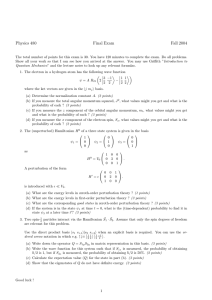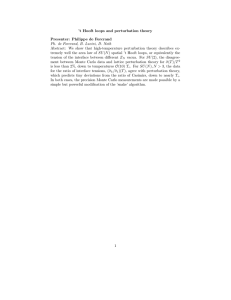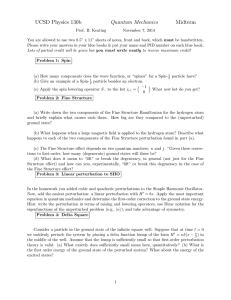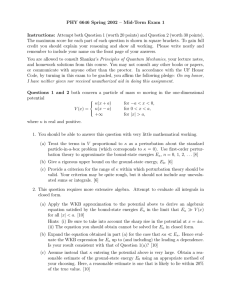Document 13492581
advertisement
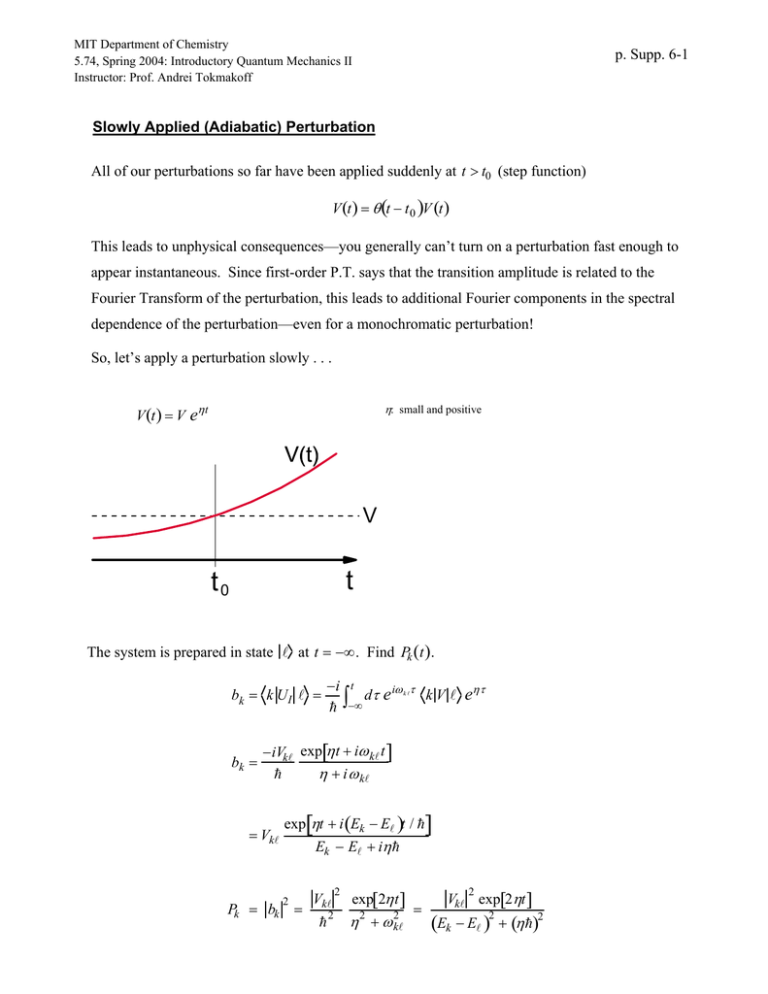
MIT Department of Chemistry 5.74, Spring 2004: Introductory Quantum Mechanics II Instructor: Prof. Andrei Tokmakoff p. Supp. 6-1 Slowly Applied (Adiabatic) Perturbation All of our perturbations so far have been applied suddenly at t > t0 (step function) V (t ) = θ (t − t 0 )V (t ) This leads to unphysical consequences—you generally can’t turn on a perturbation fast enough to appear instantaneous. Since first-order P.T. says that the transition amplitude is related to the Fourier Transform of the perturbation, this leads to additional Fourier components in the spectral dependence of the perturbation—even for a monochromatic perturbation! So, let’s apply a perturbation slowly . . . V (t ) = V eη t η: small and positive V(t) V t t0 at t = −∞ . Find Pk (t ). The system is prepared in state bk = k UI bk = = −i t ∫−∞ dτ e iω k τ eητ kV − iVk exp[η t + iω k t ] η + iωk = Vk exp[ηt + i (Ek − E )t / Ek − E + iη 2 Pk = bk = Vk 2 2 exp[2η t ] = η 2 + ω 2k ] Vk 2 exp[2ηt ] (Ek − E ) 2 + (η )2 p. Supp. 6-2 This is a Lorentzian lineshape in ω k with width 2η . Step Response Perturbation Gradually Applied Perturbation 2π 2η ωkl 0 / t ωkl The gradually turned on perturbation has a width dependent on the turn-on rate, and is independent of time. (The amplitude grows exponentially in time.) Notice, there are no nodes in Pk . η−1 is the effective turn-on time of the perturbation: Now, let’s calculate the transition rate: V ∂P w kl = k = k2 ∂t 2 2η e 2 η t η2 + ωk2 Look at the adiabatic limit; η → 0 . setting e2 ηt → 1; and using wk = 2π 2 Vk 2 δ ( ωk ) = 2π lim η = πδ ( ωk 2 η → 0 η + ω2k Vk 2 δ ( Ek − E ) ) We get Fermi’s Golden Rule—independent of how perturbation is introduced! p. Supp. 6-3 If we gradually apply the Harmonic Perturbation, V (t ) = V eηt cosωt i ωτ + e −i ωτ i ω k τ + ητ e d τ V e ∫−∞ k 2 i ω +ω t i(ω k −ω )t Vk η t e ( k ) e = e + 2 − (ω k + ω ) + iη − (ω k − ω ) + iη bk = −i t Again, we have a resonant and anti-resonant term, which are now broadened by η . If we only consider absorption: Pk = bk 2 V = k 4 2 2 e 2η t 1 (ω k − ω) + η2 2 which is the Lorentzian lineshape centered at ω k = ω with width ∆ ω = 2η . Again, we can calculate the adiabatic limit, setting η → 0 . We will calculate the rate of transitions ω k = ∂Pk / ∂t . But let’s restrict ourselves to long enough times that the harmonic perturbation has cycled a few times (this allows us to neglect cross terms) → resonances sharpen. wk = π Vk 2 2 2 δ ( ωk − ω) + δ ( ωk + ω)
